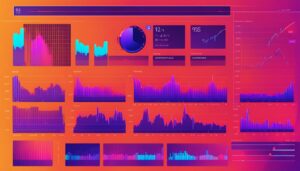Are you new to Forex trading and want to learn how to trade successfully? You’ve come to the right place! In this beginner’s guide, I will help you navigate the world of Forex trading, providing you with essential tips, strategies, and tools to kickstart your journey to becoming a successful trader.
Trading in the Forex market can be daunting at first, but with the right knowledge and approach, anyone can master it. By understanding the market, developing a solid trading strategy, and utilizing the right platforms and tools, you’ll be well on your way to achieving your trading goals.
Key Takeaways:
- Understand the basics of the Forex market and how it operates.
- Develop a trading strategy based on technical or fundamental analysis.
- Manage your risk effectively and stick to your trading plan.
- Choose a reliable Forex trading platform that suits your needs.
- Utilize essential trading tools such as indicators and economic calendars.
Now, let’s dive deeper into each of these aspects to help you gain a comprehensive understanding of Forex trading and set yourself up for success.
Understanding the Forex Market
The Forex market is a global marketplace where traders exchange national currencies, making it the largest financial market in the world. Unlike other financial markets, such as stocks or commodities, the Forex market operates 24 hours a day, five days a week, allowing traders to participate at their convenience.
The Forex market is decentralized, meaning there is no central exchange. Instead, trading takes place electronically over-the-counter (OTC), where buyers and sellers connect through electronic communication networks (ECNs) or directly with each other. This decentralized nature of the Forex market provides liquidity and allows for continuous trading.
Traders in the Forex market primarily focus on trading currency pairs, which involve the simultaneous buying of one currency and selling of another. The most commonly traded currency pairs include EUR/USD, GBP/USD, and USD/JPY. These pairs are traded based on their exchange rates, which are influenced by various economic, political, and social factors.
Spot Forex and CFDs
In Forex trading, Spot Forex involves the physical exchange of one currency for another at the current market rate. Traders buy or sell the actual currency, taking ownership of that currency. This is the traditional method of trading Forex and is commonly used by institutions, corporations, and individual traders.
On the other hand, Contract for Difference (CFD) trading allows traders to speculate on the price movements of a currency pair without owning the underlying asset. CFDs are popular among retail traders as they provide access to the Forex market with smaller capital requirements and the ability to go long or short on a currency pair.
Understanding Pips, Spread, Margin, and Leverage
Pips are the basic unit of measurement in the Forex market and represent the smallest incremental movement in a currency pair’s exchange rate. Most currency pairs are priced to four decimal places, with one pip equal to 0.0001. However, some currency pairs, such as the Japanese yen (JPY), are priced to two decimal places, with one pip equal to 0.01.
The spread is the difference between the bid price (the price at which traders sell the currency pair) and the ask price (the price at which traders buy the currency pair). The spread represents the cost of executing a trade and can vary depending on market conditions and the liquidity of the currency pair.
Margin and leverage are important concepts in Forex trading. Margin is the amount of money required to open and maintain a position in the market, expressed as a percentage of the total position size. Leverage allows traders to control larger positions in the market with a smaller amount of capital. However, it’s important to note that while leverage can amplify profits, it can also magnify losses, and traders should use it responsibly.
Developing a Trading Strategy
To trade Forex successfully, you need a well-defined trading strategy. This strategy can be based on technical analysis, which involves using charts and indicators to predict price movements, or fundamental analysis, which involves analyzing economic and political factors that impact currency values.
Technical analysis allows traders to make decisions based on historical price patterns and various technical indicators. By studying charts and identifying trends, support and resistance levels, and other patterns, traders can anticipate potential price movements and make informed trading decisions.
Fundamental analysis focuses on understanding the underlying factors that drive the value of currencies. This includes analyzing economic indicators such as GDP, inflation, employment data, and central bank decisions. Additionally, political events and geopolitical tensions can also impact currency values. Traders who employ fundamental analysis aim to identify undervalued or overvalued currencies based on the assessment of these factors.
Regardless of the approach you choose, risk management is crucial for protecting your capital. This involves setting proper stop-loss orders and position sizing based on your risk tolerance. Having a trading plan is essential to stay disciplined and avoid impulsive trading decisions driven by emotions.
Before trading with real money, it is advisable to practice your strategy using demo accounts. These accounts allow you to trade in a simulated environment without risking real money. It is an excellent way to fine-tune your strategy and become familiar with the trading platform.
Backtesting is also vital in developing a trading strategy. It involves testing your strategy on historical market data to see how it would have performed in the past. This helps you evaluate the strategy’s effectiveness and make any necessary adjustments.
Moreover, forward testing is equally important. It involves applying your strategy to real-time market conditions using a demo account or small position sizes. This allows you to assess how your strategy performs in current market conditions and helps you gain confidence in its effectiveness.
| Trading Strategy Development Checklist |
|---|
| Create a well-defined trading strategy |
| Choose between technical and fundamental analysis |
| Implement risk management techniques |
| Develop a trading plan |
| Practice on demo accounts |
| Backtest your strategy |
| Forward test your strategy in real-time |
By developing a solid trading strategy, considering both technical and fundamental analysis, managing your risk effectively, and practicing on demo accounts, you can increase your chances of success in Forex trading.

Choosing a Trading Platform and Tools
When it comes to Forex trading, selecting the right trading platform is crucial for executing your trades with ease and efficiency. One of the most popular and widely used platforms in the industry is MetaTrader 4. It provides traders with advanced charting and analysis tools, making it easier to analyze market trends and make informed trading decisions. Another popular option is MetaTrader 5, offering similar features and functionalities.
Both MetaTrader 4 and MetaTrader 5 provide a user-friendly interface, customizable charts, and a wide range of technical indicators. These platforms also support automated trading through the use of expert advisors (EAs), allowing traders to automate their strategies and execute trades automatically. With the help of EAs, traders can take advantage of opportunities in the market even when they are not actively monitoring their trades.
Aside from choosing the right trading platform, there are various trading tools that can enhance your trading experience and improve your chances of success. Let’s take a look at some of these tools:
- Trading Signals: Trading signals are alerts or notifications that provide entry and exit points for trades. These signals are generated by experienced traders or trading algorithms and can be a valuable resource for traders, especially beginners. By following trading signals, traders can take advantage of profitable trading opportunities without having to conduct their own analysis.
- Economic Calendars: Economic calendars provide information about upcoming economic events, such as interest rate decisions, employment reports, and GDP releases. These events can have a significant impact on currency prices. By staying informed about these events through economic calendars, traders can anticipate market movements and adjust their trading strategies accordingly.
- News Feeds: News feeds provide real-time market news and analysis from reputable sources. Staying updated with the latest news can help traders understand market trends, identify potential trading opportunities, and make informed decisions. News feeds can be integrated into trading platforms, allowing traders to access relevant news directly from their trading interface.
By utilizing these trading tools in combination with a reliable trading platform like MetaTrader 4 or MetaTrader 5, traders can enhance their trading strategies and increase their chances of success in the Forex market.
Conclusion
Trading Forex successfully requires knowledge, discipline, and practice. As a beginner, it is crucial to understand the basics of the Forex market. Familiarize yourself with concepts such as currency exchange, trading currency pairs, spot Forex, and CFDs. Learn about pips, spreads, margin, and leverage to make informed trading decisions.
Developing a trading strategy is essential. Consider using technical analysis with charts and indicators or fundamental analysis by analyzing economic and political factors. Don’t forget about risk management and the importance of having a trading plan. Practice your strategy using demo accounts, and evaluate its effectiveness through backtesting and forward testing.
Choosing the right trading platform and tools is vital for success. Explore platforms like MetaTrader 4 or MetaTrader 5, which offer advanced charting and analysis capabilities. Utilize trading signals to find entry and exit points, economic calendars to stay updated on upcoming events, and news feeds for market analysis. Stay informed and adapt your trading approach as necessary.
Remember to manage your risk effectively and maintain patience and discipline in your trading. With dedication and a strong foundation, anyone can learn to trade Forex successfully. Keep learning, stay adaptable, and continuously refine your strategies. By following these steps and techniques, you can navigate the Forex market with confidence and achieve your trading goals.
FAQ
What is Forex trading?
Forex trading is the exchange of national currencies in the global marketplace. Traders buy and sell currency pairs, such as EUR/USD or GBP/JPY.
What is the difference between spot Forex and CFDs?
Spot Forex involves buying and selling the actual currency, while CFDs allow traders to speculate on price movements without owning the asset.
What are pips and spreads in Forex trading?
Pips are the base unit of currency pairs, representing the smallest increment of price movement. The spread is the difference between the bid and ask price.
What is margin and leverage in Forex trading?
Margin is the amount of capital required to open and maintain a position, while leverage allows traders to trade larger positions with a smaller amount of capital.
How can I develop a trading strategy?
You can develop a trading strategy based on technical analysis, using charts and indicators to predict price movements, or fundamental analysis, analyzing economic and political factors that impact currency values.
Why is risk management important in Forex trading?
Risk management is crucial for protecting your capital. It involves setting stop loss and take profit levels, and determining the appropriate position size for each trade.
What is a trading plan?
A trading plan is a set of rules and guidelines that outline your trading strategy, risk management approach, and trading goals. It helps you stay disciplined and consistent in your trading.
How can I practice trading without risking real money?
You can open a demo account with a Forex broker, which allows you to practice your trading strategy using virtual funds. This helps you gain experience and confidence before trading with real money.
What are MetaTrader 4 and MetaTrader 5?
MetaTrader 4 and MetaTrader 5 are popular trading platforms for Forex trading. They offer advanced charting and analysis tools, as well as the ability to execute trades.
What are trading signals, economic calendars, and news feeds?
Trading signals are alerts that provide entry and exit points for trades. Economic calendars show upcoming economic events that may impact currency prices. News feeds provide market news and analysis.
How can I become a successful Forex trader?
To become a successful Forex trader, you need knowledge, discipline, and practice. Understanding the basics of the Forex market, developing a trading strategy, choosing the right platform and tools, and continuously learning and adapting are key steps towards success.





